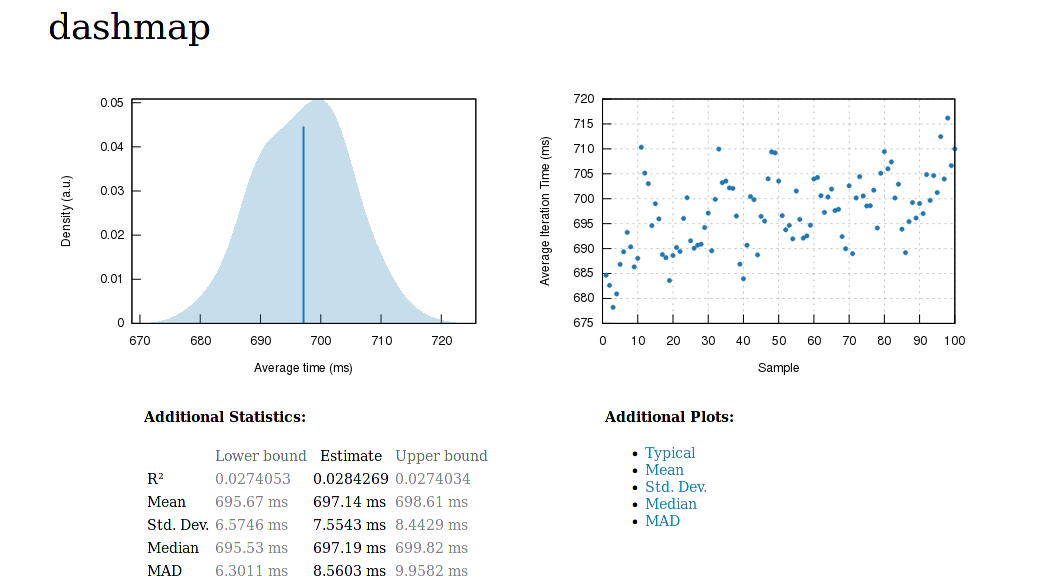9 releases
| 0.3.2 | Aug 4, 2023 |
|---|---|
| 0.3.1 | Aug 1, 2023 |
| 0.3.0 | Jun 29, 2023 |
| 0.2.4 | May 8, 2023 |
| 0.1.0 |
|
#926 in Concurrency
77 downloads per month
150KB
1K
SLoC
Linked Atomic Random Insert Vector
Lariv is a thread-safe, self-memory-managed vector with no guaranteed sequential insert. It internally uses a linked ring buffer, that unlike traditional ring buffers, is growable, and very importantly, it doesn't reallocate the whole buffer as part of the process. It has been born inside the TPR project, and it is designed for storing client connections on TPR servers, which usually are short-lived data that have to be accessed via 128-bits integers. This is basically the DashMap for vectors.
Lariv is quite similar to a traditional vector, except for being able to remove any elements at any index (not just the last one) without copying the posterior elements. Lariv is lock-free, with a worst-case O(n) smart insert algorithm that tries to keep inserts at a fast constant speed. Reallocations are wait-free, and lookups (needed for getting and removing) are O(n/capacity). Even though Lariv is designed for short-lived data, it works on most multithreaded scenarios where a vector-like data structure is viable. Lariv has been optimized for better cache locality; these optimizations yield equal performance for small elements (e.g. a few words), but manage to yield an ~20% performance increase for big elements (e.g. 4KB).
It is recommended to over-budget on the size by quite a lot, at least 50% of the averaged expected occupied size, and ideally 100% or 200%. This is required to keep data contention low, and avoid having threads fighting over the available spaces. Reallocations only happen when the algorithm assumes the buffer is kind of full, and this either happens when (a) it is full, or (b) elements aren't actually getting deleted (less than 30% since the last check) and that could and will impact performance. That is actually a bug, but I made it a feature and added fancy percentages.
Code Examples
use std::thread::scope;
use lariv::{Lariv, LarivIndex};
fn example() {
// The Lariv is backed by a collection of buffers
// distributed across nodes, and you need to specify
// the amount of elements each one holds at most.
let capacity = 50;
let lariv = Lariv::new(capacity);
let ptr = &lariv;
scope(|s| {
for i in 1..=330 {
// Some processing that is pushed to the Lariv.
// The insertion order is completely random,
// if you need it to be sorted append the correct index
// with the data, `i` on this case, and sort it later.
// The alternative is having threads starve waiting on
// a lock, which often is not ideal at best.
s.spawn(move || ptr.push(i.to_string()));
}
});
// Iterate the Lariv and do something with the data.
for e in lariv {
println!("{e}");
}
}
Safety
Miri with tree borrows doesn't complain. If you encounter a bug, open an issue please.
Performance
Very performant, as far as I am aware of. If you have a suggestion for improving performance; I pray you to open a PR please. It is significantly faster than DashMap (see below), but as a side-note, Lariv is a vector and DashMap is a hashmap, so it's not an apples-to-apples comparison. Here DashMap is just the score to beat since it is a data structure which can be used in the same places as Lariv, and it is also the de facto multithreaded hashmap in Rust.
Benchmarks, 30000 operations per sample with 4KB elements


Conclusion
Lariv is quite faster than DashMap, and has a more consistent latency. Thus, applications that require consistent latencies like e.g., games, video conferences, among others, might prefer to use it. I think Lariv is ready for production use, and it works well, but I don't deem myself responsible for crashes on production, thermonuclear war, or your soon-to-be-wife breaking up with you because you had to debug prod during your wedding; and so do DashMap's maintainers. Kudos to Joel Wejdenstål (the dashmap developer), he's awesome.